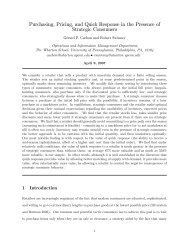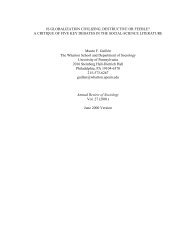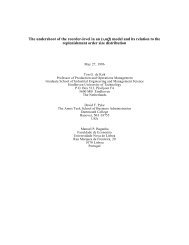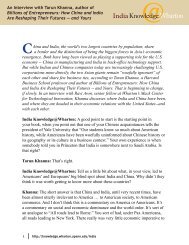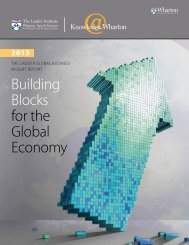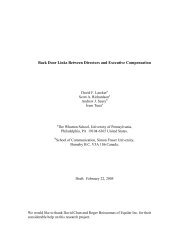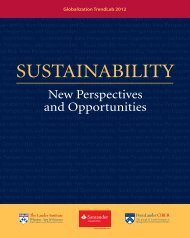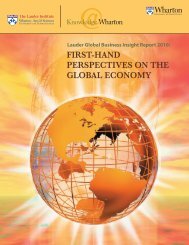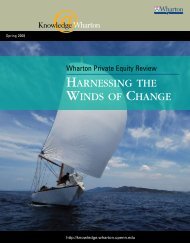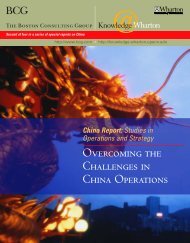The Lauder Global Business Insight Report 2011 - Knowledge ...
The Lauder Global Business Insight Report 2011 - Knowledge ...
The Lauder Global Business Insight Report 2011 - Knowledge ...
Create successful ePaper yourself
Turn your PDF publications into a flip-book with our unique Google optimized e-Paper software.
Kicking off the World Cup in Brazil<br />
In 2007, FIFA selected Brazil to host the World Cup<br />
in 2014. This decision is in line with FIFA’s strategy of<br />
rotating the World Cup between the continents and<br />
giving new emerging economies the opportunity to<br />
host. <strong>The</strong> selection was, therefore, not a surprise: A<br />
South American country had not hosted the event<br />
since 1978, and Brazil’s recent economic and political<br />
performance continues to amaze the world. As Ronaldo<br />
Helal, professor of sociology at the State University of<br />
Rio de Janeiro and author of “Passes e Impasses: Futebol<br />
e Cultura de Massa no Brasil” (Passes and Impasses:<br />
Football and Mass Culture in Brazil), noted in a recent<br />
interview, “<strong>The</strong> country has experienced 16 years of<br />
economic stability, 20 years of democratic rule, and has<br />
done well during the economic crisis that affected most<br />
developed countries in the past few years.”<br />
Currently the eighth largest economy in the world and the<br />
largest in Latin America, Brazil was expected to have a<br />
GDP growth of 7.8% during 2010. Unlike most countries,<br />
the 2008 crisis had a quasi-imperceptible impact on its<br />
economy, with a -0.2% GDP growth in 2009.<br />
Salvador, founded in 1549 and capital of Brazil<br />
until 1763, is one of the 12 cities selected to host the<br />
competition (along with Belo Horizonte, Brasilia,<br />
Cuiabá, Curitiba, Fortaleza, Manaus, Natal, Porto<br />
Alegre, Recife, Rio de Janeiro, and São Paulo). <strong>The</strong><br />
city is one of the cultural hearts of the country, and its<br />
colonial historical center, Pelourinho, was declared a<br />
World Heritage Site by UNESCO in 1985. Salvador has<br />
a population of 2.9 million inhabitants and is the third<br />
largest city in Brazil, although considerably smaller<br />
than São Paulo (10.9 million) and Rio de Janeiro (6.1<br />
million). Salvador contributes about 1% of national GDP<br />
and occupies the 11th place nationally. However, due<br />
to its high level of inequality, the city occupies the 23rd<br />
position in GDP per capita at R$9,240 (US$5,400). In<br />
comparison, the city of São Paulo has the highest GDP<br />
per capita at R$29,394 (US$17,200).<br />
Salvador’s largest economic sector is tourism, and it<br />
is currently the second most popular destination in<br />
Brazil after Rio de Janeiro. According to the city’s local<br />
government, commercial and services activities account<br />
for 75% of the city’s economy and industrial activities<br />
42 <strong>Knowledge</strong>@wharton • <strong>Lauder</strong> <strong>Global</strong> <strong>Business</strong> <strong>Insight</strong> <strong>Report</strong> <strong>2011</strong><br />
account for 25%. <strong>The</strong> Port of Salvador, located in Bahia<br />
Todos Los Santos, is the largest port in the northeastern<br />
region of Brazil.<br />
Hosting a World Cup is not an easy venture, especially<br />
in a developing country like Brazil. Looking toward the<br />
World Cup, each host city has to be prepared in three<br />
main areas: the stadium, airport and transportation,<br />
and accommodations for tourists. Salvador will<br />
receive financing and investments of approximately<br />
R$1.24 billion (US$730 million), of which about R$1<br />
billion (US$588 million) will come from the federal<br />
government — approximately 6% of the government’s<br />
total planned investment in World Cup preparations.<br />
<strong>The</strong> remainder will be provided primarily by the state<br />
of Bahia. Observers see this as an enormous net gain<br />
for Salvador and a significant opportunity for the city to<br />
improve its infrastructure.<br />
Fonte Nova stadium<br />
FIFA requests that host nations have stadia with seating<br />
capacities ranging from 40,000 to 60,000 and be adapted<br />
to specific standards, regardless of their locations and<br />
plans for long-term usage. Unfortunately, Salvador’s<br />
Fonte Nova Stadium does not currently adhere to these<br />
norms and is thus in the midst of a major renovation.<br />
According to Adriana B. Dantas, from the department<br />
in charge of World Cup projects at BNDES (Banco<br />
Nacional de Desenvolvimento Economico e Social),<br />
“the demolition and reconstruction of the Fonte Nova<br />
Stadium will cost R$714 million (US$417 million), from<br />
which R$400 million (US$234 million) will come from<br />
BNDES funding.” <strong>The</strong> new stadium will have a capacity<br />
for approximately 50,000 people and will include 50<br />
suites for 1,000 people, a press area for 1,600 journalists<br />
and a VIP area for 2,500 guests.<br />
One of the key issues when building new stadia is to<br />
have a plan in place to maximize their use once the<br />
event is over, according to Derrick Heggans, Managing<br />
Director of the Wharton Sports <strong>Business</strong> Initiative.<br />
This is precisely one of the concerns often associated<br />
with organizing mega events such as the World Cup.<br />
Cities end up with stadia that are not used regularly<br />
and become known as “white elephants.” Although<br />
there are two important football teams in the Bahian<br />
capital (SC Bahia and Vitoria FC), analysts fear that



